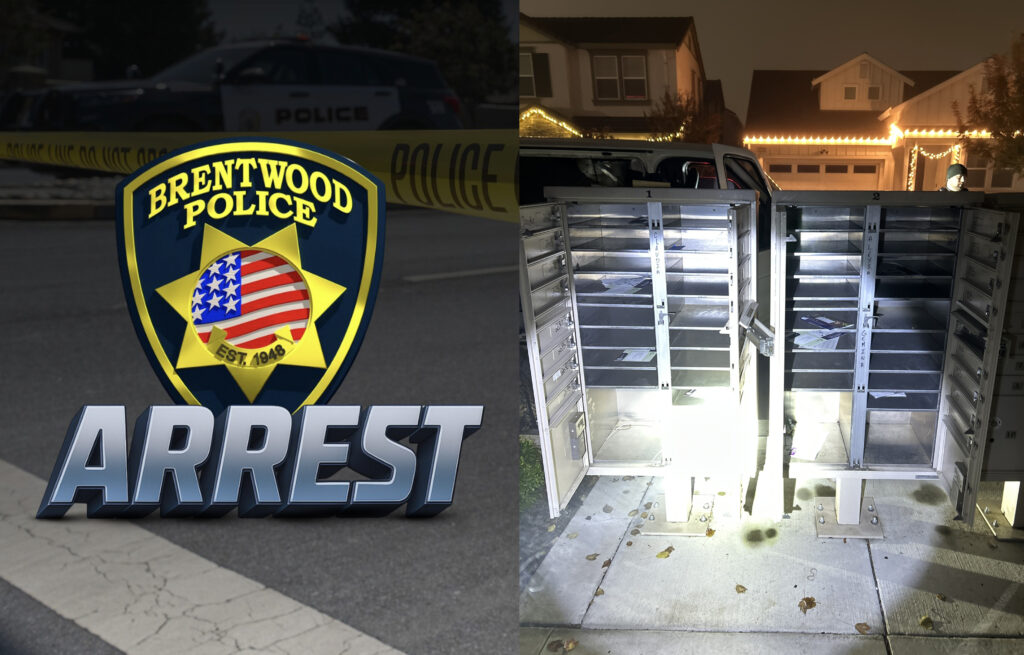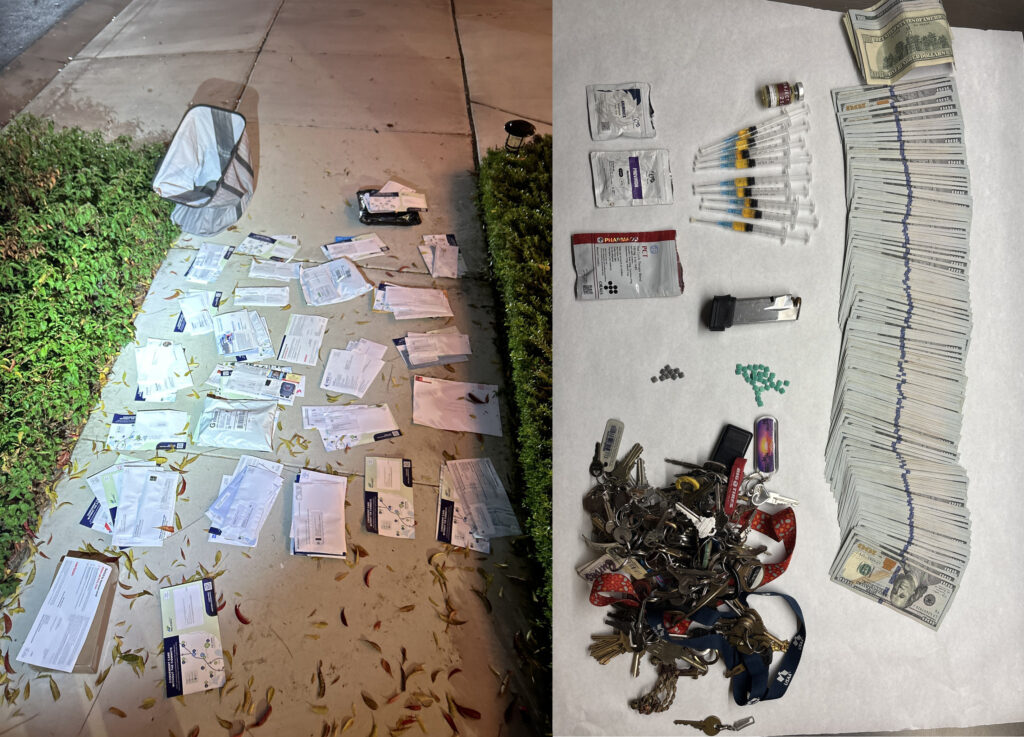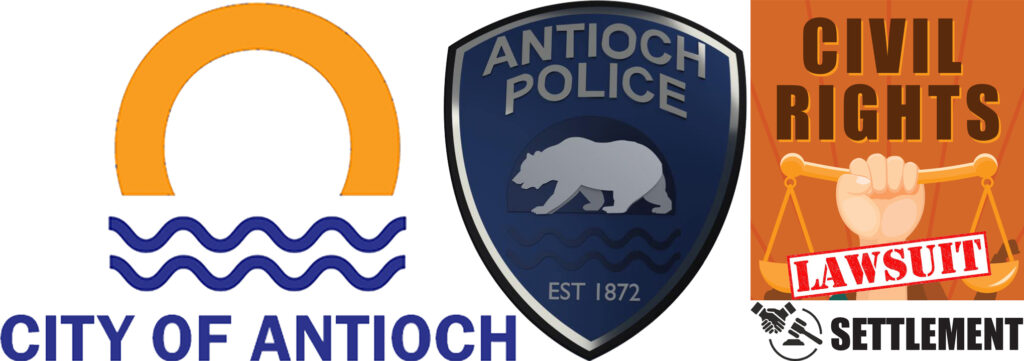One of 8 Kaiser Nor Cal hospitals to meet rigorous standards and demonstrate their commitment to high-quality maternity care
By Elissa Harrington, Sr. Media Relations & PR Rep, Kaiser Permanente Northern California
ANTIOCH, CA – Eight Kaiser Permanente Northern California hospitals are designated as “2026 Best Hospitals for Maternity Care” by U.S. News & World Report for providing high-quality maternity care to patients.
The eight Kaiser Permanente Northern California hospitals to receive the prestigious honor are: Antioch, Manteca, Modesto, Redwood City, Roseville, San Jose, Santa Clara and Vacaville.
This is the highest award a hospital can earn as part of U.S. News’s Best Hospitals for Maternity Care annual study.
U.S. News recognizes hospitals that meet rigorous standards in caring for patients with uncomplicated pregnancies. These ratings are intended to help expectant parents, in consultation with their prenatal care team, make informed decisions about where to receive maternity services that best meet their family needs.
Last year, nearly 40,000 babies were delivered within Kaiser Permanente Northern California hospitals.
“Kaiser Permanente Northern California is continually recognized for providing high-quality, exceptional maternity care to families as they embark on this exciting time in their lives,” said Mike Bowers, FACHE, interim president of Kaiser Permanente’s Northern California region. “Our labor and delivery teams focus every day on caring for our patients in a warm and nurturing environment, providing them with a positive birth experience.”
Kaiser Permanente Northern California has a long-standing commitment to excellence in maternal health and creating a positive maternity care experience for our patients and members. Our comprehensive maternity care focuses on safe, high-quality care from prenatal to postpartum, including midwife services, prenatal classes, and support for breastfeeding and mental health.
“This recognition highlights the unwavering dedication of our physicians, midwives, nurses, and staff, who consistently provide high-quality care for parents and their newborns,” said Maria Ansari, MD, FACC, chief executive officer and executive director of The Permanente Medical Group. “We take great pride in delivering safe, compassionate, and exceptional maternity care, supporting parents through every stage—before, during, and after birth.”
U.S. News & World Report, the global authority in hospital rankings and consumer advice, began evaluating maternity care hospitals in 2021, rating hospitals that provide labor and delivery services and submit detailed data to the publication for analysis.
This year, the national designation was awarded to only 495 hospitals in the United States, or about 55 percent of the 899 hospitals that participated.
Methodology is based entirely on objective measures of quality, such as C-section rates in lower-risk pregnancies, severe unexpected newborn complication rates, exclusive breast milk feeding rates, birthing-friendly practices, and reporting on racial/ethnic disparities, among other measures.
About Kaiser Permanente Antioch Medical Center Birthing Center
As you prepare to welcome your new baby, the care team at Kaiser Permanente Antioch looks forward to taking this journey with you. Count on us to support you through your pregnancy, empower you to have the birth experience you want to have, and give your baby a happy, healthy start in life.
Kaiser Permanente Antioch features CenteringPregnancy. This is a nationally-recognized style of prenatal care in a group setting. Its aim is to build a community that empowers women to be actively involved in their own care and equips them to make healthy choices throughout their pregnancy and beyond.
Kaiser Permanente Antioch Medical Center is located at 4501 Sand Creek Road off Deer Valley Road in Antioch.
About Kaiser Permanente
Kaiser Permanente is committed to helping shape the future of health care. We are recognized as one of America’s leading health care providers and not-for-profit health plans. Founded in 1945, Kaiser Permanente has a mission to provide high-quality, affordable health care services and to improve the health of our members and the communities we serve. We currently serve 12.5 million members in 8 states and the District of Columbia. Care for members and patients is focused on their total health and guided by their personal Permanente Medical Group physicians, specialists, and team of caregivers. Our expert and caring medical teams are empowered and supported by industry-leading technology advances and tools for health promotion, disease prevention, state-of-the-art care delivery, and world-class chronic disease management. Kaiser Permanente is dedicated to care innovations, clinical research, health education, and the support of community health. For more information, go to about.kp.org
About U.S. News & World Report
U.S. News & World Report (USNWR, U.S. NEWS) is an American media company publishing news, consumer advice, rankings, and analysis. The company was launched in 1948 as the merger of domestic-focused weekly newspaper U.S. News and international-focused weekly magazine World Report. In 1995, the company launched its website, usnews.com, and, in 2010, ceased printing its weekly news magazine, publishing only its ranking editions in print. U.S. News licenses its name to the subjects it ranks, so they may then use the annual rankings in promotional literature. www.usnews.com
Read More‘Tis the season to also slow down!
By Jaime Coffee Director of Communications Office of Media Relations, California Highway Patrol
SACRAMENTO — The California Highway Patrol (CHP) encourages the public to “brake” the habit of speeding this holiday season. The CHP will launch a Christmas Holiday Enforcement Period (HEP) starting at 6 p.m. on Wednesday, December 24, and ending at 11:59 p.m. on Thursday, December 25.
During last year’s 30-hour holiday enforcement effort for Christmas, CHP officers arrested over 300 impaired drivers in just 30 hours, issued 2,251 speeding tickets – including 132 to motorists going over 100 mph. Tragically, during that same time period, at least 17 people lost their lives in crashes across the state.
Every celebration starts with a smart choice. Always designate a sober driver before the festivities begin. If you plan to drink, plan your ride—use a rideshare, public transportation or call a trusted friend. Make this holiday season unforgettable for all the right reasons.
“Every instance of speeding or reckless driving carries the potential for life-changing consequences. Our officers see the destruction these choices can cause, and we urge every driver to slow down, stay alert, and make decisions that protect themselves and others. No destination is worth risking a life.” – CHP Commissioner Sean Duryee
Removing dangerous drivers from California’s roads remains a top priority for the CHP. To support this goal, the CHP and the Department of Motor Vehicles recently launched Forwarded Actions for Speeding Tickets, or FAST, a pilot program that speeds up the process of removing drivers who exceed 100 mph from the roads. FAST automatically sends these citations to the DMV’s Driver Safety Branch, which can suspend or revoke a license. The CHP has also deployed 100 low-profile, specially marked patrol vehicles that have issued nearly 33,000 speed-related citations since May.
These steps, along with the upcoming Christmas HEP, send a clear message to drivers: slow down or face being stopped. Every decision behind the wheel matters, and obeying the speed limit can make the difference between arriving safely or not at all.
Additionally, winter weather can present significant challenges for motorists, particularly as storms impact roadways across the state. Rain, snow, and debris can quickly change driving conditions, reducing visibility and traction and increasing the risk of collisions.
To help everyone get home safely for the holidays, the CHP urges drivers to slow down, allow extra following distance, and remain alert for hazards such as standing water, rockslides, mud, or icy pavement.
Before traveling, check the weather and road conditions, ensure vehicles are properly equipped, and adjust driving behavior accordingly. Patience and preparedness are critical, as arriving safely is always more important than arriving on time.
The mission of the CHP is to provide the highest level of Safety, Service, and Security.
Read More
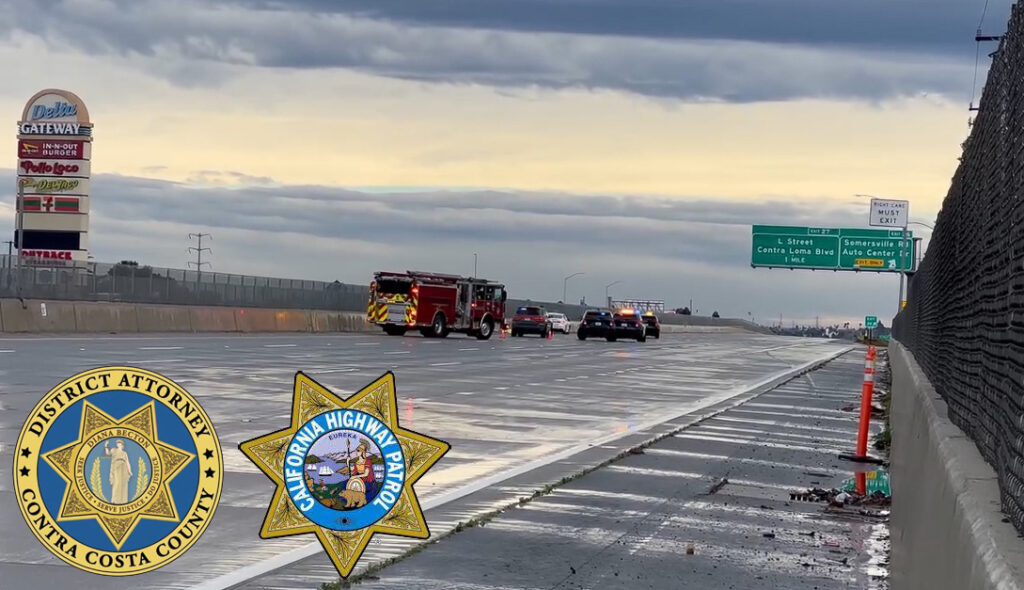
Antioch Police and Con Fire personnel responded to the scene of the fatal collision causing a back-up in the eastbound lanes of Highway 4 between Pittsburg and Antioch Monday morning, Dec. 22, 2025. Video screenshot courtesy of Spotlight CoCoCounty.
Following collision involving DA Senior Inspector killing Antioch assault suspect running on Hwy 4; CHP leads investigation
By Ted Asregadoo, PIO, Contra Costa County District Attorney’s Office
Martinez, California – A fatal traffic collision with a pedestrian is under investigation by the California Highway Patrol pursuant to the County Law Enforcement Involved Fatal Incident Protocol.
On Monday, December 22, 2025, at approximately 10:35 a.m., in the area of Delta Fair Blvd. in Antioch, a suspect engaged in a disturbance at Delta Bowl. According to Antioch Police, the initial incident occurred at the Comfort Inn, located at 2436 Mahogany Way, where the 27-year-old male suspect had pulled a fire alarm and then struck a 47-year-old male security guard. As police responded, the suspect climbed over a fence and entered eastbound Highway 4 on foot.
The individual was struck in the roadway by an oncoming county vehicle driven by a District Attorney Senior Inspector whose duties were unrelated to the disturbance. The pedestrian was pronounced deceased at the scene.
The California Highway Patrol is the venue agency conducting the traffic collision investigation. The California Department of Justice has been notified. The Contra Costa County District Attorney’s Office has yielded legal analysis to avoid a potential conflict of interest. The investigation is ongoing.
Allen D. Payton contributed to this report.
Read MoreSmash-and-grab suspects flee scene; shopper shares her experience, claims “whole mall was…evacuated”
By Concord Police Department
On Sunday, December 21, 2025, at approximately 11:53 a.m., Concord Police Department dispatch received multiple reports of a smash-and-grab robbery at a jewelry store inside Sunvalley Mall. Suspects used hammers to break display cases before fleeing the scene in a waiting vehicle.
Officers arrived within two minutes of the initial calls. While some witnesses initially reported possible gunfire, officers quickly confirmed that no shots were fired during the incident.
The suspects had fled toward the highway prior to officers’ arrival. There were no reported injuries, and there is no ongoing threat to the public. The incident remains under investigation.
In a Facebook post by Yolanda Schamoni who was shopping in the mall at the time, she shared her experience.
“We just had the scariest experience at Sun Valley Mall. I was there with my son and grandson. We don’t know what happened yet whether it was a shooting with the robbery or just a robbery, but all of a sudden the whole mall was being evacuated my son was standing in line for us to see Santa while I took my grandson to the bathroom and the next thing I know everyone’s running for the exits I was upstairs my son was downstairs thank you to the good Samaritan family that kept him safe until we were reunited, but I can tell you being locked in stores when you’re just out to have your kids sit with Santa because someone’s robbing with guns is not the best feeling.
“Please, I urge the parents out there to start parenting their children. These are kids that parents must know something is going on if they’re going somewhere with guns and robbing people parents do better.”
Allen D. Payton contributed to this report.
Read MoreBy Contra Costa County Sheriff’s Office
The Contra Costa Sheriff’s Office continues to investigate a homicide that occurred on Monday, December 15, 2025, at 8:04 a.m. at a home on the 5100 block Laurel Drive in unincorporated Concord.
Valley Station deputy sheriffs responded to a welfare check and found a resident of the home deceased on the property. Detectives believe the incident began as a domestic issue when a family dispute escalated into an altercation. Three others who suffered from injuries were transported to a local hospital.
The victim is identified as 38-year-old Antonio Valdez of Antioch. A person in the home who suffered injuries remains in the hospital.
The Investigation Division Homicide Unit and Crime Lab responded to the scene. Detectives believe the incident began as a domestic issue when a family dispute escalated into an altercation. There are no outstanding suspects and no threat to the public.
The investigation is ongoing. Anyone with any information on this incident is asked to contact the Investigation Division at (925) 313-2600. For any tips, email: tips@so.cccounty.us or call (866) 846-3592 to leave an anonymous voice message.
Read More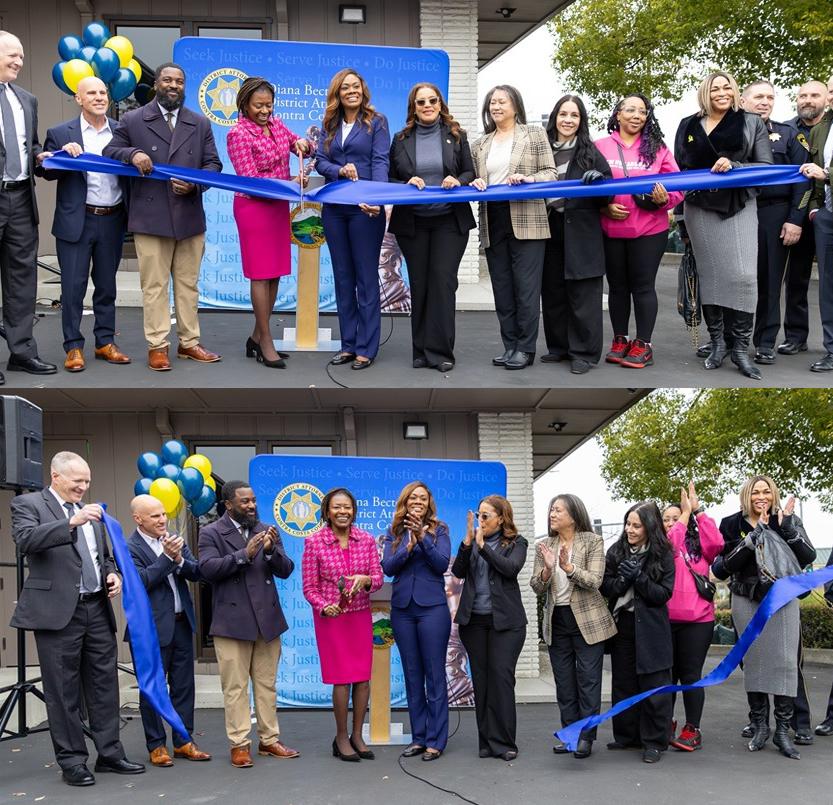
Contra Costa DA Diana Becton (in magenta) is joined by District 5 Supervisor Shanell Scales-Preston, East County officials and others as she cuts the ribbon on the new CCDA branch office in Pittsburg on Monday, Dec. 15, 2025. Photo credit: Glenn Kimball, Contra Costa County Office of Communications and Media
“We’re Open for Business!”
By Ted Asregadoo, PIO, Contra Costa District Attorney’s Office
On Monday, Dec. 15, 2025, Contra Costa District Attorney Diana Becton cut the ribbon at the Grand Opening of our newest branch office at 3890 Railroad Avenue in Pittsburg.
We were honored to have special guests join us, including District 5 County Supervisor Shanelle Scales-Preston, Pittsburg Mayor Dionne Adams, Antioch Mayor Ron Bernal, Pittsburg Councilman Jelani Killings, Brentwood Councilwoman Jovita Mendoza, Antioch Councilwoman Tamisha Torres-Walker, Pittsburg Police Chief Steve Albanese, Antioch Police Captain Desmond Bittner and NAMI Contra Costa CEO Gigi Crowder. Several delivered remarks before the ribbon-cutting ceremony and office tour.
Thank you to everyone who celebrated this milestone — two years in the making! We’re grateful for the dedication of our District Attorney’s staff who made this possible.
We’re fully staffed and ready to serve the communities of East Contra Costa County!
Read More
Craig Whiteley, Jr. fled scene with two other suspects; found with keys, drugs, cash, ammo
By Brentwood Police Department
In the early morning hours of December 14, 2025, at approximately 5:38 a.m., Brentwood Police officers responded to a report of suspicious activity near community mailboxes in the 2700 block of Empire Avenue.
A witness reported seeing three male suspects flee on foot after being startled, leaving behind the vehicle they arrived in. When officers arrived, they found the community mailboxes had been compromised and stolen mail belonging to multiple residents was located inside the suspect vehicle, which had been left running.
Officers quickly set up a search of the surrounding area and located 37-year-old Craig Allen Whiteley, Jr. from Antioch who matched the suspect description and appeared to have recently fled on foot. A records check revealed the individual was on felony probation for firearm- and mail theft-related offenses.
During the investigation, officers recovered evidence linking the suspect to the mail theft. A subsequent search led to the discovery of keys used to access mail boxes, narcotics intended for sale and ammunition.
The suspect was arrested and booked into County Jail on charges including probation violation, mail theft, narcotics possession and additional related offenses.
All 22 victims had their stolen mail successfully recovered and returned.
Excellent work by our graveyard officers for their swift response and diligent investigation.
Residents are encouraged to report suspicious activity immediately to help keep our neighborhoods safe.
According to the Brentwood Police website, Whitely is five-feet, 11-inch tall, 160-pound white male.
According to the Contra Costa County Sheriff’s Office, as of Dec. 17, 2025, at 9:11 PM, Whitely was out of custody with no charges filed.
Allen D. Payton contributed to this report.
Read MoreAgreement aligns with U.S. DOJ reforms; this part of case only includes attorney’s fees
By Allen D. Payton
The City of Antioch announced Friday morning, Dec. 19, 2025, it has reached a settlement agreement “that strengthens accountability and transparency in the Antioch Police Department (APD) through updated policies, independent oversight and measurable reporting. The agreement is structured to align with the U.S. Department of Justice Memorandum of Agreement (MOA) governing APD reforms.”
The settlement is subject to court approval and is associated with Trent Allen, et al. v. City of Antioch, et al., United States District Court, Northern District of California (Case No. 3:23-cv-01895-TSH), a class action lawsuit against the City, as well as police officers and chiefs. As previously reported, Allen is one of four suspects convicted of the 2021 murder of Arnold Marcel Hawkins and the attempted murder of Aaron Patterson. He and a variety of other plaintiffs claimed civil rights violations by the officers.
Oakland civil rights attorney John Burris and associates filed the lawsuit in April 2023, naming five then-current and former officers, for their racist and other offensive texts and mistreatment of citizens, plus, three past police chiefs, the City of Antioch and Does 1-100. (See related articles here and here)
The plaintiffs included Shagoofa Khan, the 2017 Antioch Youth of the Year who was one of the lead protesters in the city in 2020, was arrested a few times including once for felony arson in January 2021 and at former Chief Tammany Brooks’ farewell party later that year, and was the subject of one of the vile texts; Adam Carpenter, Joshua Butler, Diego Zavala, the son of Guadalupe Zavala, who was unarmed when he was shot and killed by police in 2021 after a seven-hour stand-off with police (whose last name is listed in the lawsuit as Savala), and Allen, whose murder case resulted in the release of the texts.
The suit described what occurred between the named Antioch Police officers and the plaintiffs as a “conspiracy and/or conspiracies” and claims they were “the failure and/or refusal (by the former chiefs)…to prevent or aid in preventing” them from occurring. The suit further claimed the four department leaders “maintained customs, policies, and/or practices which encouraged, authorized, condoned, ratified, failed to prevent, and/or failed to aid in the prevention of wrongs conspired to be done by” the named officers.
The suit sought multiple forms of damages including “past, present and/or future wage loss, income and support, medical expenses”; special damages, any and all permissible statutory damages, and attorneys’ fees.
UPDATE & CORRECTION: According to City Manager Bessie Scott, the settlement does not include any money. But she later shared the City will pay attorney’s fees. Then during the press conference on Friday, Dec. 19, Burris said, “There were two parts of the case, one involving the individuals, which we settled, 23,” earlier in the year. Those did involve payments which will be reported on later once City staff has provided a response to the Public Records Act request by the Herald.
Independent Consultant to Oversee Settlement Provisions
The settlement will be administered by the same independent consultant responsible for oversight under the U.S. DOJ MOA to ensure coordinated implementation and consistent monitoring.
The independent consultant will oversee APD’s implementation of the settlement’s provisions, including providing technical assistance, reviewing affected policies, and issuing regular reports on APD’s progress toward substantial compliance. The independent consultant will also ensure APD remains in substantial compliance for the required period of time. If APD is not making adequate progress, the monitor may seek further orders of the court to compel compliance.
The independent consultant is required to report to the City Council every six months. Reports to Council will be public. The City also anticipates public reporting related to community engagement/community policing efforts and statistics on traffic stops and police interactions related to use of force.
“This settlement agreement reinforces the reform work already underway, ensures sustainable transparency measures and updates core policies to modernize how APD continues to provide constitutional policing services to the residents of Antioch,” said Scott.
“This agreement will ensure we continue prioritizing the community and safety,” said Chief of Police Joe Vigil. “We will continue working towards greater transparency, accountability and community engagement as we work through this agreement.”
Key elements of the settlement include:
Expanded transparency and oversight
- Data collection and analysis requirements
- Audits and reviews
- Reporting requirements to track progress and compliance
Policy and procedure updates to modernize APD operations
- Non-discriminatory policing
- Use of force, including canine deployment
- Hiring and promotions
- Complaint intake, review, and resolution
- Supervisor responsibilities and accountability
- Police officer communications
- Body-worn camera use
Community engagement
- Provisions to expand APD’s community engagement and support accountability through public-facing practices.
The City will provide additional information as implementation milestones are established.
Jaden Baird, City of Antioch PIO contributed to this report.
Read MoreFour locations
By Contra Costa County Fire Protection District
THIS WEEKEND!
Contra Costa County Fire Protection District and the United Professional Firefighters Association of Contra Costa County Local 1230 are partnering to collect new, unwrapped toys for children in our communities!
Celebrate the season with Santa at one of his four stops across the county! Donate a toy, enjoy cookies and cocoa, and meet your local firefighters!
Fire Station 10- 2955 Treat Blvd., Concord
Friday, December 19, 3:00 PM – 5:00 PM
Fire Station 82- 196 Bluerock Drive, Antioch
Saturday, December 20, 10:00 AM – Noon
Fire Station 92- 201 John Muir Parkway, Brentwood
Saturday, December 20, 5:00 PM – 7:00 PM
Fire Station 76- 1680 Refugio Valley Road, Hercules
Sunday, December 21, 5:30 PM – 7:30 PM
For more information about Con Fire visit www.cccfpd.org.
Read MoreBy Contra Costa Health
Contra Costa County must prepare for significant reductions in Medi-Cal coverage and hundreds of millions of dollars in long-term funding loss as a result of recent federal and state policy changes, county officials said Tuesday.
New federal requirements under H.R. 1, the “One Big Beautiful Bill Act,” combined with state Medi-Cal eligibility and reimbursement changes, will make it harder for many residents to enroll in or keep healthcare coverage. While final details are still emerging, county estimates indicate that as many as 93,000 Contra Costa residents could be affected by 2029.
At the same time, Contra Costa Health (CCH) projects more than $300 million in cumulative state and federal funding reductions through 2029, driven by Medi-Cal disenrollment and cuts to supplemental funding that public hospitals rely upon. These impacts are expected to grow year over year and reflect a broader trend affecting counties and public health systems across California.
“These changes mean fewer people covered and fewer dollars coming into the system at the same time,” said Candace Andersen, Chair of the Contra Costa County Board of Supervisors. “Our responsibility is to face that reality head-on, plan carefully, and ensure the county continues to provide essential care for residents who have nowhere else to turn.”
During a presentation to the Board on Tuesday, leaders of CCH and the county’s Employment & Human Services Department (EHSD) emphasized that the projected impacts are a result of external policy decisions, not local performance, and that significant uncertainty remains around timelines, enforcement and the response from California.
Federal guidance on several provisions of H.R. 1 has not yet been issued, and California’s approach to mitigating coverage losses is still evolving.
The presentation outlined how specific provisions of H.R. 1 and recent state Medi-Cal policy changes are expected to reduce enrollment, increase administrative barriers to coverage, and lower reimbursement to safety-net providers. It also reviewed projected enrollment losses, funding impacts to CCH and Contra Costa Health Plan, and the anticipated timing of changes, along with areas of ongoing uncertainty.
The Board directed CCH to return in early 2026 with a proposal to update and strengthen the county’s existing supports for people who are not eligible for Medi-Cal and have no other healthcare options.
Contra Costa County will share additional updates as federal and state guidance becomes available and planning continues.
Read More











